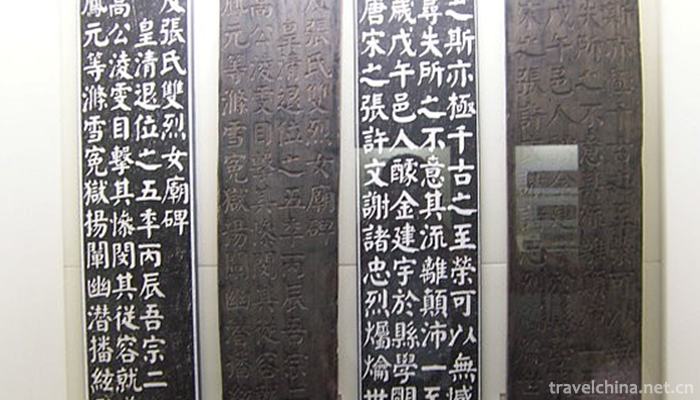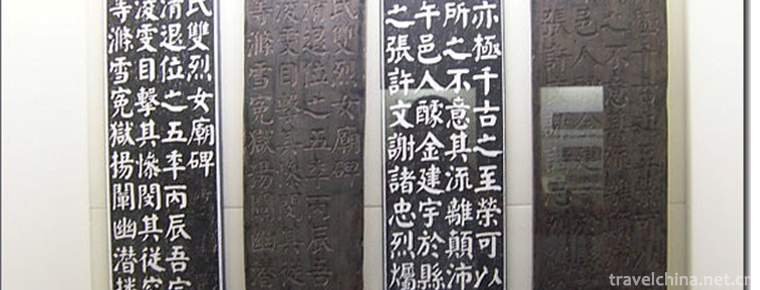Rubbing and Printing Skills of Hengshui Inscriptions
Rubbing and Printing Skills of Hengshui Inscriptions
Hengshui Law Tie Engraving and Printing Technology, the traditional handicraft of Taocheng District, Hengshui City, Hebei Province, is one of the national intangible cultural heritage.
The history of Hengshui wooden carving can be traced back to Tang Dynasty. It flourished in Ming Dynasty and Qing Dynasty. Its exquisite carving skills fully show the exquisite Chinese character calligraphy.
On May 23, 2011, Hengshui Law's engraving and rubbing technology was approved by the State Council and listed in the third batch of national intangible cultural heritage list, item number_-201.
historical origin
The history of the rubbing of Yanzhuang calligraphy can be traced back to the Tang Dynasty. In the eighteenth year of Tang Zhenguan (644), when the sick Taifu Gavenda of Shu Dynasty died in Chang'an, he was buried in the ancestral Tomb of Dongge Village in Taocheng District of Hengshui. The inscription was written by the great calligrapher of Tang Dynasty, Zhu Suiliang Shudan. Businessmen sell rubbings on-site, and rubbings are widely circulated. Later, people in the nearby counties of Hengshui County followed the example of businessmen selling rubbings. For a time, rubbings, papermaking and ink making rose among the villagers around Dongge Village. After thousands of years, to the nineteenth year of Emperor Kangxi of Qing Dynasty, "Hengshui County Chronicle" has a record of "today's peeling off" of the Gavenda tablet.
During the Northern Song Dynasty, the government prevailed to print the calligraphy of predecessors into ink collection. When the wise Hengshui people saw the inconvenience of engraving on the stone tablets, they copied the calligraphic ink of the famous masters of the past dynasties on the wooden board and then printed and mounted them, and sold them in volumes. Because the board is easy to handle and the engraving is time-saving and labor-saving, it has a great role in promoting the industrialization of the later rubbing technology.
In the late Ming Dynasty, Yan Rongzhang, a man named Yan Rongzhang, was an apprentice at the Tie Paver of Liulichang in Beijing. After returning to the village, he handed down the technique of carving Tie to the villagers of Yan Jiazhuang. Villagers handed it down from generation to generation. Everyone took carving as his skill and making Tie as his career. By the middle of Qing Dynasty, Yan Jiazhuang's carving of Fa Tie had formed an industrial chain. At the end of the Qing Dynasty and the beginning of the Republic of China, Yanjiazhuang Fa Tie entered the capital. According to the book "Xiao Zhi of Liulichang" compiled by Sun Dianqi, a Jizhou native, there are shops in the cultural street of Liulichang in Hengshui, where Yan Shizhu and Yan Bingyi master and apprentice operate Fa Tie and print calligraphy album pages. They are "Yimotang" opened in Guangxu 20 years and "Yunzhu Dun" opened in the 16th year of the Republic of China. During this period, because of the idea of reform, advocating new learning, setting up schools in the society, advocating equality between men and women, children were enrolled in school to study and learn Chinese characters. For a time, there was a great demand for copies of traditional calligraphy. This also promoted Yan Jiazhuang's calligraphy to expand the scale of production and operation. At that time, besides selling in Beijing, Tianjin and Hebei, Hengshui cultural traders also traveled to Shanxi, Shaanxi and China. Mongolia, Liaoning and other places for export.
By the outbreak of the War of Resistance Against Japan, Hengshui Tie had ceased because of the war, the founding of New China, the rise of new technology, the lack of access to traditional skills, the local legacy of Tie rubbings, rubbings and other precious cultural relics were destroyed as the "Four Old" in the "Cultural Revolution", surviving hundreds of old Tie boards has been a very small part. Since the 1990s, with the state's emphasis on the protection of cultural relics, Hengshui Tie Printing Technology has been listed in the national intangible cultural heritage protection list. The government has made great efforts to inherit this traditional technology by appointing inheritors, building museums and supporting the development of cultural industries.
Inheritance significance
Inheritance value
Hengshui Tie Printing Technology is not only an ancient printing technology that once promoted the spread of Chinese calligraphy art, but also an art that can be replaced by modern printing as a printing technology. However, as an art, it incorporates the producer's understanding and emotion of the original calligraphy art, and is converted into paper art form through woodcut and rubbing. This kind of production experience is essentially a kind of artistic creation, which has artistic value.
Inheritance status
There are fewer and fewer people who study Hengshui law stamp engraving and printing technology, which makes Hengshui law stamp engraving and printing technology face the problem of inheritance.
Inheriting characters
Yan Changhao, male, Han nationality, born in 1934 in Taocheng District, Hengshui City, Hebei Province. In 2008, he was selected as the representative successors of the first batch of intangible cultural heritage projects in Hebei Province.
Li Guangmin, male, Han nationality, born in 1972 in Taocheng District, Hengshui City, Hebei Province. In 2013, he was selected as the representative successors of the third batch of intangible cultural heritage projects in Hebei Province.
protective measures
In 1994, the State Administration of Cultural Relics allocated special funds to build the "Museum of Law Ties" in Baoyun Monastery.
In 2009, the Taocheng District Committee and the District Government of Hengshui City invested 700,000 yuan to move the Fate Museum into the People's Road Study Exhibition Hall in the city center.
social influence
In March 2009, Hengshui Law's engraving and rubbing technology became the only provincial intangible cultural heritage project in Hebei Province to participate in China's Intangible Cultural Heritage Exhibition Conference in Beijing.
In January 2011, the first cross-regional exchanges were achieved between block printing and French print rubbing, with "World Heritage" and "National Heritage" joining hands.


-
1.legend of butterfly lovers Liang Zhu
Legend of Liang Zhu (Legend of Liang Shanbo and Zhu Yingtai) is a sad and moving love story. It is also called four ancient Chinese folklores with Meng Jiangnu, Niulang Zhinu and White Snake Biography
Time 2018-12-23 -
2.Putuo Zong Cheng
Putuo Zongcheng Temple, located in the north of Chengde Summer Resort and south of Shizigou, Hebei Province, covers an area of 220,000 square meters
Time 2019-02-07 -
3.Taiyuan Qingxu Baoyuan Old Vinegar Workshop
Taiyuan Qingxu Baoyuan Old Vinegar Workshop is located in Taiyuan City, Shanxi Province. It is the "Taiyuan Youth Heritage and Education Base". It has been awarded the "First Industrial
Time 2019-02-13 -
4.Diabolo
Diabolo is a splendid flower in Chinese traditional culture garden. Diabolo used to be called "Hu Dao", also known as "ground bell", "empty bell", "wind gourd".
Time 2019-04-28 -
5.Sebin Festival of Ewenki Nationality
"Serbin" is an Ewenki language, meaning "happy and peaceful". Sebin Festival is a traditional festival of the Ewenki people. On Sebin Festival, Ewenki hunters gather together
Time 2019-04-28 -
6.Xuzhou Qinshu
Xuzhou Qinshu is a kind of opera recognized by Xuzhou local people in Jiangsu Province. Spread in Xuzhou. At first, it was a recreational activity of "playful friends" in the leisure time of
Time 2019-07-09 -
7.leshan normal university
Leshan Teachers College was founded in 1978 and approved by the Ministry of Education in March 2000. The former Leshan Teachers College and Leshan Education College were merged and upgraded to general
Time 2019-08-31 -
8.Lao Tzu
Laozi, surnamed Li Minger, is a character of Bai Yang, or posthumous Bo Yang. In the late spring and Autumn period, the birth and death years were unknown. About 571 years ago, it was born in the late
Time 2019-09-04 -
9.Taoping Qiang Village
Taoping Qiang village is located in Taoping Township, beside Zagunao River in Lixian County. Qiang village is 40 km away from Lixian City, 16 km from Wenchuan city and 139 km from Chengdu. It is a national key cultural relics protection unit and an important scenic spot in Jiuhuang line tourism circle.
Time 2020-11-07 -
10.Neijiang in yuan Ming and Qing Dynasties
In 1279, China was unified and the Yuan Empire was established. After more than 30 years of war between the end of Song Dynasty and the beginning of Yuan Dynasty, the system of Zizhou and Puzhou has not been restored except Jianzhou. In the 22nd
Time 2020-12-16 -
11.Administrative division of Nanchong
Nanchong City governs nine county-level administrative divisions (Municipal District 3, county-level city 1, county-level 5), and 241 township level administrative divisions (street 42, town 161, township 38). It covers an area of 12514 square kilometers and has a population
Time 2020-12-17 -
12.Nanchongs tertiary industry
In 2019, investment in real estate development in Nanchong will increase by 23.6% compared with that in 2018. The construction area of commercial housing was 31.8726 million square meters, an increase of 23.5% over that in 2018, of which the newly started
Time 2020-12-17